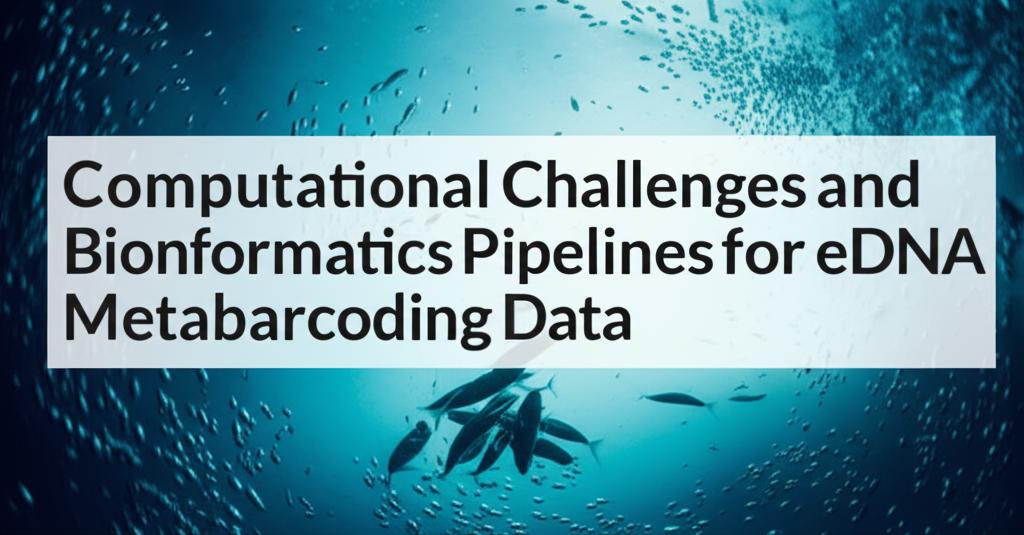Environmental DNA (eDNA) metabarcoding has revolutionized biodiversity assessment, allowing scientists to detect species presence across diverse environments like water, soil, and air without directly capturing organisms. This powerful technique involves amplifying and sequencing short, standardized DNA regions (barcodes) from environmental samples to identify multiple species simultaneously. However, processing the massive amounts of sequencing data generated presents significant computational hurdles and necessitates sophisticated bioinformatics pipelines.
The Bioinformatics Pipeline: From Raw Data to InsightsA typical eDNA metabarcoding bioinformatics pipeline transforms raw sequencing reads into meaningful ecological data through a series of critical steps:
- Data Pre-processing: This initial phase often involves merging paired-end reads (if applicable) to reconstruct the full barcode sequence. Subsequently, reads are demultiplexed, meaning they are sorted into separate files based on unique tags (barcodes) assigned to each sample during library preparation. Adapter and primer sequences used in the amplification process are also trimmed away.
- Quality Filtering: Raw sequencing data contains errors. This step removes low-quality reads and sequences that fall outside expected length parameters, improving the accuracy of downstream analyses.
- Sequence Processing:
Dereplication: Identical sequences are collapsed into unique representative sequences, along with their read counts. This significantly reduces computational load.
Chimera Removal: PCR amplification can sometimes artificially combine sequences from different parent molecules, creating chimeras. These artifact sequences are identified and removed.
- Clustering or Denoising: This is a crucial step to identify biologically meaningful sequences.
Clustering: Groups similar sequences into Operational Taxonomic Units (OTUs) based on a defined similarity threshold (e.g., 97%).
Denoising: Newer algorithms (like DADA2 or Deblur) aim to resolve sequences down to the single-nucleotide difference, inferring exact Amplicon Sequence Variants (ASVs). ASVs potentially offer finer taxonomic resolution and better reproducibility compared to OTUs.
- Taxonomic Assignment: The representative OTU or ASV sequences are compared against curated reference databases (like GenBank, BOLD, SILVA, or custom databases) using algorithms like BLAST or VSEARCH. This step assigns taxonomic identities (e.g., species, genus, family) to the sequences.
- Table Generation: The final output is typically an abundance table (or feature table), similar to a traditional ecological frequency table, listing the identified taxa (OTUs/ASVs) present in each sample and their associated read counts or relative abundance.
- Statistical Analysis and Interpretation: Ecological and statistical analyses are performed on the abundance table to explore biodiversity patterns, community composition, species distributions, and compare diversity across different samples or treatments.
Despite advancements, analyzing eDNA metabarcoding data poses several computational challenges:
- Data Volume and Storage: High-throughput sequencing generates massive datasets, often hundreds of gigabytes per run. Storing, transferring, and managing this data requires significant computational infrastructure.
- Processing Power: Many bioinformatics steps, especially quality filtering, denoising/clustering, and taxonomic assignment against large databases, are computationally intensive. Processing large datasets often necessitates access to high-performance computing (HPC) clusters or cloud computing resources.
- Algorithm and Parameter Choice: Numerous software tools and pipelines (e.g., QIIME2, USEARCH/VSEARCH, PEMA, Barque, mothur, FROGS, mbctools) exist, each with different algorithms and parameters. There is no single "best" pipeline for all studies; the optimal choice depends on the specific genetic marker, sequencing platform, experimental design, and research questions. Tuning parameters is often crucial for accurate results, requiring bioinformatics expertise.
- Reference Database Limitations: The accuracy of taxonomic assignment hinges entirely on the quality and completeness of reference databases. Major challenges include:
Incompleteness: Many species, particularly in less-studied regions or taxonomic groups, lack reference sequences for common barcodes. This leads to unassigned sequences or assignment only to higher taxonomic ranks (e.g., genus, family).
Errors: Databases can contain mislabeled sequences, taxonomic inaccuracies, or sequencing errors, leading to incorrect species identifications.
* Intraspecific Variation: Databases may lack sufficient representation of genetic variation within a species, potentially hindering accurate identification or leading to the splitting of a single species into multiple OTUs/ASVs.
- Error and Artifact Management: Distinguishing true biological sequences from errors introduced during PCR (chimeras) and sequencing remains a challenge. Denoising algorithms significantly improve this, but careful checks are still necessary.
- Standardization: Lack of standardized protocols across labs for both wet-lab procedures and bioinformatics analysis makes direct comparison between different studies difficult. Efforts are underway to establish best practices, but variability remains.
- Integration with Other Data: Increasingly, researchers are integrating eDNA data with other monitoring data, such as underwater imaging or traditional surveys, requiring new computational approaches for data fusion and cross-validation.
The field is rapidly evolving to address these challenges:
- Improved Algorithms: Continuous development yields faster and more accurate algorithms for denoising, chimera detection, and taxonomic assignment.
- Cloud Computing: Cloud platforms offer scalable and accessible computational resources, reducing the need for local HPC infrastructure for some users.
- User-Friendly Pipelines: Tools like QIIME2, PEMA, and mbctools offer integrated environments that streamline the execution of complex workflows, though understanding the underlying processes remains important.
- Benchmarking Studies: Researchers are actively comparing different tools and pipelines to evaluate their performance in terms of speed, accuracy, and sensitivity.
- Reference Database Curation: Significant efforts are focused on improving the quality, completeness, and taxonomic accuracy of reference databases.
- Machine Learning: AI and machine learning techniques are being explored for tasks like taxonomic classification, error detection, and pattern recognition in complex datasets.
In conclusion, bioinformatics pipelines are indispensable for extracting biological insights from eDNA metabarcoding data. While significant computational challenges related to data volume, processing power, algorithm choice, and database quality persist, ongoing advancements in algorithms, computational infrastructure, and standardization efforts are continuously improving the accuracy, speed, and accessibility of eDNA analysis, solidifying its role as a transformative tool in ecological research and biomonitoring.

